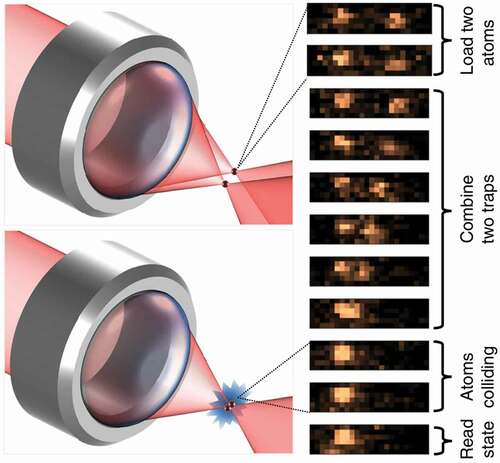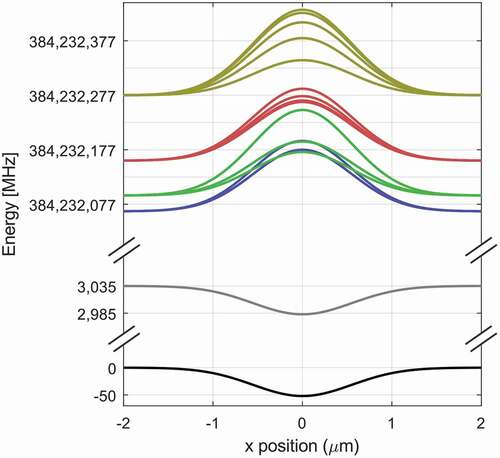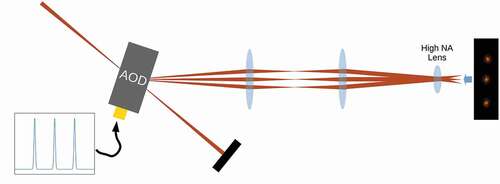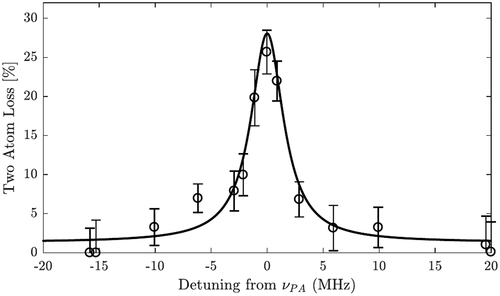Figures & data

Figure 1. Illustration of optical tweezer setup for manipulation of individual atoms. Unlabeled red arrows: Magneto optical trap beams. Figure from [Citation35].
![Figure 1. Illustration of optical tweezer setup for manipulation of individual atoms. Unlabeled red arrows: Magneto optical trap beams. Figure from [Citation35].](/cms/asset/450b6c40-fb3c-4f73-83f5-f2029b9251a3/tapx_a_2064231_f0001_oc.jpg)
Figure 2. Energy shift calculation based on EquationEquation (2)(2)
(2) for states on the D2-line of
, for a linearly polarized optical tweezer with wavelength 1064 nm focused to a spot-size of 1
. For linearly polarized light, the ground states having
has
independent light shifts. That is, all
states within each of the two
(Black) and
(gray) manifolds remain degenerate. For the excited state with
,
states within each of the manifolds
(blue),
(green),
(red), and
(army-green), experience different energy shifts.

Figure 3. Homo-nuclear light assisted collisions in alkali metals. The excited state has a long range asymptote. When light, that is red detuned from the free atom resonance, excites an atomic pair (vertical red arrow), it is transferred to the attractive excited state molecular interaction potential, from which they can spontaneously decay (red serpentine arrow). Blue detuned light (blue vertical arrow) will excite the pair to the repulsive interaction potential. Figure from [Citation47].
![Figure 3. Homo-nuclear light assisted collisions in alkali metals. The excited state has a long range C3R3 asymptote. When light, that is red detuned from the free atom resonance, excites an atomic pair (vertical red arrow), it is transferred to the attractive excited state molecular interaction potential, from which they can spontaneously decay (red serpentine arrow). Blue detuned light (blue vertical arrow) will excite the pair to the repulsive interaction potential. Figure from [Citation47].](/cms/asset/70eb0b12-4c41-43ab-b1f2-bfc75f0c1ee6/tapx_a_2064231_f0003_oc.jpg)
Figure 4. Blue detuned light assisted collisions can lead to one (path (a)) or zero (path (b)) of the collision partners being lost. When none are lost laser cooling removes the released energy and brings the pair back to the initial state and a new collision can occur. Figure from [Citation49].
![Figure 4. Blue detuned light assisted collisions can lead to one (path (a)) or zero (path (b)) of the collision partners being lost. When none are lost laser cooling removes the released energy and brings the pair back to the initial state and a new collision can occur. Figure from [Citation49].](/cms/asset/143ec211-3cdb-4349-97e3-b56fe97d1a71/tapx_a_2064231_f0004_oc.jpg)
Figure 5. When three radio-frequency signals are fed to an acousto optical deflector, three first order diffraction beams emerge. In the Fourier plane of the AOD this translates to three separate optical tweezers with positions controlled by the frequency and potential depths controlled by the power of the corresponding radio-frequency signals.

Figure 6. Atom-atom interaction experiment using movable optical tweezers. Right panel: Fluorescence images of the atoms at different positions during the experiment. Figure from [Citation74].
![Figure 6. Atom-atom interaction experiment using movable optical tweezers. Right panel: Fluorescence images of the atoms at different positions during the experiment. Figure from [Citation74].](/cms/asset/0322d08e-29ee-4244-9ec9-e96d78835338/tapx_a_2064231_f0006_oc.jpg)
Figure 7. When the photo-association laser frequency is scanned, atoms are resonantly lost in pairs as it match transitions from two free atoms to an electronically excited molecular state.

Figure 8. When pairs of thermal atoms are photo-associated, the dynamics can not be described by a single rate coefficient as in many-atom samples. The dashed lines are a fit to the data assuming a single rate coefficient, while the solid lines assumes two populations with different rate coefficients. Figure from [Citation77].
![Figure 8. When pairs of thermal atoms are photo-associated, the dynamics can not be described by a single rate coefficient as in many-atom samples. The dashed lines are a fit to the data assuming a single rate coefficient, while the solid lines assumes two populations with different rate coefficients. Figure from [Citation77].](/cms/asset/89946bb9-dc10-42a0-ba77-7cbf8bffdd0c/tapx_a_2064231_f0008_oc.jpg)
